FarSync OEM T4E - 4 port PCI / PCI-X multi clock source synchronous WAN communications card for VoIP |
|||||||||||||||||||||||||||||||||||||||||||||||||||||||||||||||||||||||||||||||||||||||||||||||||||||||||||||||||||||||||||||||||||||||||||||||||||||||||||||||||||||||||||||||||||||||||||||||||||||||||||||||||||||||||||||||||||||||||||||||||||||||||||||
The FarSync OEM T4E PCI / PCI-X intelligent card is a 4 port transparent bitstream / HDLC board with multiple clock sourcing with multipliers and dividers suitable for providing WAN communications for VoIP and other requirements. |
|||||||||||||||||||||||||||||||||||||||||||||||||||||||||||||||||||||||||||||||||||||||||||||||||||||||||||||||||||||||||||||||||||||||||||||||||||||||||||||||||||||||||||||||||||||||||||||||||||||||||||||||||||||||||||||||||||||||||||||||||||||||||||||
| Download
The FarSync OEM T4E datasheet (PDF format) |
|||||||||||||||||||||||||||||||||||||||||||||||||||||||||||||||||||||||||||||||||||||||||||||||||||||||||||||||||||||||||||||||||||||||||||||||||||||||||||||||||||||||||||||||||||||||||||||||||||||||||||||||||||||||||||||||||||||||||||||||||||||||||||||
|
|||||||||||||||||||||||||||||||||||||||||||||||||||||||||||||||||||||||||||||||||||||||||||||||||||||||||||||||||||||||||||||||||||||||||||||||||||||||||||||||||||||||||||||||||||||||||||||||||||||||||||||||||||||||||||||||||||||||||||||||||||||||||||||
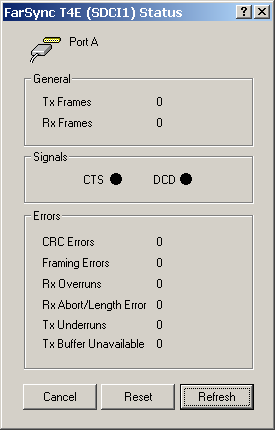 |
|
FarSync OEM T4E Line Status Utility |
 FarSync OEM T4E Hardware
FarSync OEM T4E HardwareThe card comprises a AMD processor with 1 Mbyte of on board no wait state SRAM. The whole memory space may be mapped via the PCI / PCI-X interface to the PC/Server. The AMD processor contains a quad embedded HDLC / transparent controller with SDMA access (128 buffers per port) and a full range of timers.
The T4E supports four synchronous ports which can run to speeds of up to 8.192 Mbits/s full duplex internally clocked and 10 Mbits/s externally clocked. Total bandwidth supported by the card is 60 Mbits/s. A quad port UART (async controller) is included. Async or Sync operation is dynamically selectable on each port.
Network Interfaces
The multi function line drivers available on the card support RS232C (V.24), X.21 (RS422, V.11), V.35, RS530 (EIA530) and RS449 network interfaces, all soft configurable and protected from static charges by ESD protection devices.
Clock Generation, Detection and Selection
Five on-board frequency synthesisers are configurable for generating clocks for the CTBus (H.100) and/or to the 4 serial ports.
Internally sourced clocks
Internally generated clocks to drive a serial communications port can be derived from either an on-board 8.192MHz clock (32ppm) or an CTBus bus clock and can be set to 160 different frequencies between 300 baud and 8.192 Mbits/s, the complete list is in the table below:
Table of internally generated clock rates supported by the T4EMany other frequencies can be synthesized to order, contact us to discuss your requirements.
Externally sourced clocks
External clocks received from a serial port and used to a drive serial communications port can be any frequency up to 1000KHz.
A CTBus (H.100 bus) clock may be generated from a received serial port clock for the following sub-set of frequencies: 38400, 57600, 64k, 128k, 256k, 512k, 1024k, 2048k, 4096k and 8192k.Terminal Timing
Terminal Timing is supported to enable system-wide clock synchronisation.
Clock Routing
Clocks sourced from one port can be routed to drive the other ports.
Clock Speed Detection
A 16-bit timer enables differentiation between the clock frequencies, enabling auto-configuration of clock synthesisers when cables are connected.
H.100 Bus - Special clocking options
The T4E supports a subset of the CTBus (H.100) interface to enable synchronisation of serial ports(s) to the H.100 bus (both master and slave modes), with CT_C8_A, CT_C8_B, CT_FRAME_A and CT_FRAME_B signals and jumper-selectable signal terminations. Serial port data is not frame aligned. This is of particular use in VoIP applications where a data on a line must be exactly reproduced at another location without slip.
In CT_Bus Slave mode, the CTBus clock (auto-selected with A being primary) can be used as a clock source to derive serial port clock(s).
In CT_Master mode, the CTbus clock (either A or B) can be derived from either a received serial port clock or an internal oscillator
PC / Server PCI and PCI-X Compatibility
The FarSync T4E card is suitable for systems with a PCI or PCI-X bus, covering single processor systems, all multiprocessor systems and processors featuring HyperThreading technology, including Pentium 4, Xeon and Xeon-MP CPUs. The card is PCI revision 2.2 compliant with support for both 3.3 and 5 volt signaling, the power for the card is taken from the 3.3 volt supply rail. The card may be fitted in either 32-bit PCI bus slots or 64-bit PCI-X bus slots as this Universal PCI card will work perfectly well in both.
If you are not sure about your particular system, contact us and we can provide advice on the card that is most suitable for your System.
 Multiple Cards
Multiple Cards The drivers supplied with Windows and Linux allow large numbers of ports to be supported by the installation of multiple FarSync OEM T4E cards in a Server. Typically 12 or more cards (48+ ports) can be supported; the card limit is only dependent on the resources available in the host Server.
 Windows SDCI API
Windows SDCI APIThe FarSync OEM T4E card and software provides support for an enhanced SDCI (Synchronous Dumb Card Interface) API.
Synchronous data
The SDCI API has been extended to allow applications to exactly control the type of data sent and received in both bit synchronous (HDLC framed) data and transparent bitstream formats. The SDCI SDK contains everything a user needs to rapidly develop and test applications for such requirements as supporting specialist synchronous protocols or transparent data requirements such as Audio, MPEG Video T-DMB and DAB ETI. The unique clocking options are selectable and configurable from the API.
Asynchronous Data
To operate a port with asynchronous data under Windows 2000/XP, the FarSync driver supports a subset of the standard Win32 COMM API as detailed in Microsoft's MSDN Documentation. This enables applications that currently interface to standard serial ports on Windows to be easily ported to use FarSync ports in asynchronous mode. As an alternative to using the Win32 COMM interface, SDCI clients also have the option of using much of the same code to support FarSync ports in either asynchronous or synchronous modes e.g. the same data transfer IOCTLs.
Sample Applications
A number of easy to follow sample applications are provided demonstrating the wide variety of features available with the card. This includes a kernel mode sample for those customers who require the ultimate performance. GUI based feature demonstration and test utilities are supplied capable of using the wide range of features supported by the card.Further information on the SDCI API
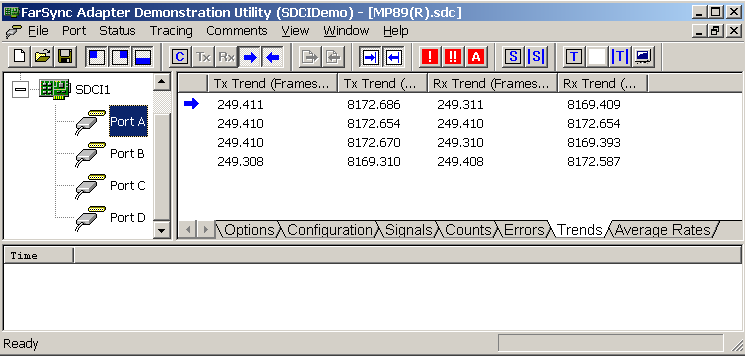 |
|
Screenshot of SDCIDemo utility program that tests
and demonstrates the FarSync OEM T4E's capabilities
|
Configuration
The product is easy to install and configure, the T4E card is 'plug-and-play' compatible supporting Windows XP, 2000 and Server 2003. Typically 12 or more cards (48+ ports) can be supported on a single Server; the card limit is only dependent on the PCI slots resources available in the Server. There is On-line help and documentation.
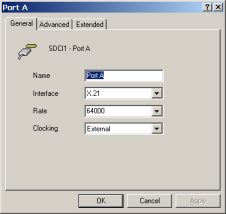 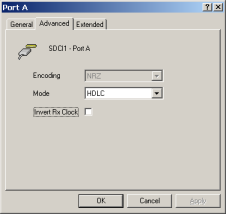 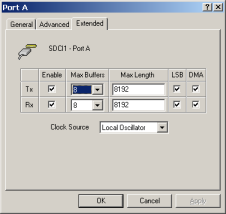 |
|
Configuration Utility Screens
|
 Linux Raw Sockets API
Linux Raw Sockets APIThe Linux API allows applications to send and receive HDLC format
(bitsync) frames and also transparent bitstreams with the raw sockets
based API. The sample application supplied with the Developers Toolkit
demonstrates both modes of operation.
Data rates of up to 10 Mbits/s are supported, with all the ports individually
selectable for speed, clocking direction and mode of operation (HDLC or
Transparent). Frame sizes up to 32 Kbytes are supported in HDLC mode to
allow support for a wide variety of specialist synchronous protocols.
The transparent bit stream is suitable for transparent data requirements
such as Audio, MPEG Video T-DMB and DAB ETI. The unique clocking options
available with the FarSync OEM T4E are selectable and configurable from
the API. The API allow the full range of internal clock speeds to be selected.
The source for the application and drivers is included, with the Linux
API manual provided in Abode PDF format. The driver is supported under
kernel version 2.4 and 2.6 for both single CPU and SMP 32 and 64 bit machines.
Typically 12 or more cards (48+ ports) can be supported on a single Server;
the card limit is only dependent on the PCI slots resources available
in the Server, the maximum within Linux is 32. For further information
on the API see the
Linux HDLC / Transparent API Manual (pdf).
 Product Packaging
Product PackagingThe product includes:
Card drivers for Windows Extended SDCI and Linux Raw Sockets APIs,
Documentation supplied on CD-ROM,
A quick start guide, the communications adapter,
The Developers Toolkit for the SDCI API and Raw Sockets API
Utility applications
Cables for the card have their own product codes and are order separately.
|
Technical Specifications
|
|
Product Name |
FarSync OEM T4E |
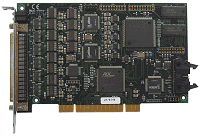 |
|
| Product Code | FS5444 |
| Warranty | 5 years |
| Port Count and Features | 4 Synchronous / Asynchronous ports, soft configurable on each port. |
|
Hardware Features |
|
| card type and size | AMD Processor with
1 Mbyte SRAM, Intelligent bus mastering Universal PCI card, Short card (height 107mm, length 167mm), 100 pin HIPPI connector for the network connections, CTBus (H.100 bus) for external clocking connection Memory mapped and DMA PC interface |
| Network Interfaces |
RS232C
(V.24, X.21bis) - 25 pin male D type, |
| Link speed range Synchronous |
X21, RS530, RS449: up to 8.192 Mbits/s internal
clocked, 10 Mbits/s externally clocked, |
| Link speed range Asynchronous | RS232C, X.21: 110, 150, 300, 600, 1200, 2400, 4800, 9600, 19200, 38.4K, 57.6K & 115.2 Kbits/s |
| Maximum total bandwidth | 60 Mbits/s |
| PCI / PCI-X bus interface | PLX PCI9054 - bus mastering,
DMA enabled, Universal signaling PCI-X compatible, PCI v2.2 compliant, Supports 3.3 & 5 volt signaling, Suitable for 32 and 64 bit PCI bus slots |
| Multiple cards | 12 or more; only dependant of the number of PCI slots available on the server |
| Line indicators | 4 LEDs one per port showing line connection status |
| ESD Protection | Yes, Littelfuse high speed ESD and over-voltage protection |
| MTBF | 141,438 hours calculated using Bellcore Method 1 Case 3, 40 deg.C ambient, 15 deg.C case temperature rise above ambient |
| Approvals | EN55022 class B, CE, FCC class B |
| RoHS Compliance | See the RoHS news item |
| Power requirements | < 1.75 A @ +3.3v, < 10mA @ +/- 12v, < 6 watt. Note: 5 volt supply not required |
| Line clocking - internal | Internal clock range:
over 160 different frequencies between 300 baud and 8.192 Mbits/s.
See the complete list. No special cables are required to use internal clocks. Internal clocking is supported on RS530, RS232C, X.21, V.35 and RS449 connections |
| Line clocking - external | External clocks received
from a serial port and used to a drive serial communication sport
can be any frequency up to 8.192MHz. For a specific sub-set of frequencies (38400, 57600, 64k, 128k, 256k, 512k, 1024k, 2048k, 4096k, 8192k) an H.100 bus clock may be derived from a received serial port clock. |
| Terminal timing | Terminal Timing is supported to enable system-wide clock synchronisation. |
| Clock speed detection | A 16-bit timer enables differentiation between the clock frequencies listed above, enabling auto-configuration of clock synthesisers when cables are connected. |
| H.100 Bus - special clocking options | The T4E supports a subset of the H.100 interface to enable synchronisation of serial ports(s) to the H.100 bus in both master and slave modes. |
| Cables | Cables are ordered separately, see the Cables section for details |
|
Software Features |
|
| Example Applications | Linux Raw Sockets sample
application, Windows SDCI sample application, Windows Kernel level sample application. All example applications are in C, source provided. |
| Line Drivers | Fully functional bit
sync and transparent bitstreaming line drivers supplied for Windows
XP, 2000, Server 2003 and Linux. The Linux driver includes source and is supported under kernel versions 2.4 and 2.6 for both single CPU and SMP 32 and 64 bit machines. |
| Utility Applications | Windows and Linux applications demonstrating the cards features. |
|
Manuals |
|
| Programming Manual | Programming Reference manuals in PDF format provided, includes details on the hardware and sample software. |
| API Manuals | FarSync OEM Linux Raw Sockets Reference Manual, FarSync Windows SDCI SDK Reference Manual |
 Cables
CablesThis four port card uses a single large high density 100 pin HIPPI type connector, all four lines are available though this connector. The quad port cable HCR4 attaches to the T4E card and splits out the four network interfaces into separate network connectors to provide support for EIA-530 and RS232C. X.21, V.25 and RS449 are available through transition connectors. Details of the cables and converters available are listed in the table below. Crossover cables, sometimes referred to as null modem cables are available, they are also detailed in the table.
|
FarSync OEM T4E - Compatible Cables
|
|||
| Product Name | Cable Photos | Description | Product Code |
| Cables for the FarSync OEM T4E | |||
| HCR4 | HCR4, Quad port EIA-530 and RS232C cable, 2.0 metres for use with FarSync OEM T4E cards. Also supports X.21, V.35 and RS449 interfaces with addition of conversion cables TCX1, TCV1 and TC449 respectively. | FS6076 | |
| TCX1 | TCX1, X.21 (V.11) DB-15M 1 port HCR4 cable to X.21 transition connector for the FarSync OEM T4E card | FS6052 | |
| TCV1 | TCV1, V.35 V.35M 1 port HCR4 cable to V.35 transition connector for the FarSync OEM T4E card | FS6053 | |
| TC449 | TC449, RS449 DB-37M 1 port HCR4 cable to RS449 transition connector for the FarSync OEM T4E card | FS6054 | |
| Special Purpose Cables for all T-Series cards | |||
| Null-MX | X.21 double shielded
crossover cable, 15 pin D type female connectors, 0.5 metres.
Suitable for FarSync T-Series cards, see pinouts |
FS6090 | |
| X21-EXT | X.21 double shielded 15 metre extension cable, 15 pin D type female to 15 pin D type male connector | FS6091 | |
| Null-MR3 | V.24 (RS232C) double
shielded crossover cable, 25 pin D type female connectors, 0.5
metres. Suitable for FarSync T-Series cards, see pinouts |
FS6092 | |
Last updated: 21-Oct-2007